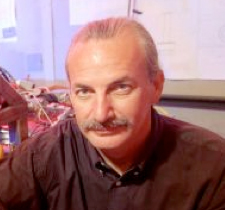Don Eigler joined IBM in 1986 after completing his post-doctoral work at Bell Labs and getting his Ph.D. in physics at the University of California, San Diego (while surfing in his spare time). In his free moments these days, Don enjoys classic science fiction, backpacking in the Sierra Nevada and, of course, restoring cars. He lives in the redwood-forested Santa Cruz mountains with his wife Roslyn and their two dogs.
You and your colleagues spelled out IBM using thirty-five individual atoms, what were you thinking?

I was thinking many things. One of the things I wanted to achieve was an incontrovertible demonstration that we could position atoms with atomic-scale precision over and over again. I have long held that reproducibility is at the very core of experimental science. It is what distinguishes science from pseudo-science. So I wanted a way to clearly demonstrate that we could reproducibly put the atoms where we wanted them to go. Writing out “IBM” accomplished this goal, but I think your question is more along the lines of why “IBM” instead of, say, “ATOM” or “MOM.” The answer to that question is really very simple: pay back time. I was (and still am) incredibly beholden to the company, and the individuals in the company, that gave me a job when I needed one, and then provided me with every opportunity and resource I needed to achieve professional success. Writing out “IBM” with Xenon atoms was a way of providing return on the investment. But even more, there was a sense of loyalty and pride that this was a BIG BLUE accomplishment.
Was it hard to do? Did you have to spend late nights in the lab?
The actual writing of IBM took 22 hours with a few breaks. Sometimes I would get a letter finished and then mess it up and have to go back and position the atoms again. Nowadays it would take about fifteen minutes. Was it hard? The 22 hours were as delightful as I imagine the first flight of the Wright brothers at Kittyhawk must have been. The hard part was the 5 years of work (two after completing my PhD and working in a university, three at IBM) pioneering low-temperature Scanning Tunneling Microscopy. As for late nights… I have spent countless late nights in the lab. Comes with the territory.
So you do this work but you really can’t see what is going on until you look at it under microscope, were you nervous that it might not work?
Not nervous at all. “STOKED” or “PUMPED” or “AMPED” would be a more appropriate description of my mental state. It is always exciting to see the atom appear just where you intended to place it.
Some of the things that you created are really cool to look at but can you tell us a bit about why this technology is important?
You are mistaken if you think that what we have done in the lab is technology. What we have done is exploratory science that helps to broaden the foundations of knowledge upon which information technologies are built. Without extending those foundations, we can only go so far before progress grinds to a halt. Is keeping the IT (information technology) revolution going important? You betcha!
Did you want to be a scientist when you were a kid?
As a kid I was always designing and building gizmos and trying to make them work. Now that I am an adult (ha ha ha) the only difference is that people pay me to do it! I am gizmologist with a love of nature and an unquenchable curiosity about how nature works. I guess that makes me scientist?
Ten years from now will nanotechnology change our lives?
It all depends upon what you call nanotechnology. Rather than get everyone confused about what is or what is not nanotechnology, let’s just think about the role that nanometer-scale structures play in our lives and are likely to play in the future. From the transistors in the computer on which I am composing this sentence, to the coatings on the window in front of me, to the drugs and chemicals that are already a part of everyday life, nanometer-scale structures are crucially important. As time goes on, our ability to engineer and fabricate new and useful nanometer-scale structures will only increase. Nanotech will have a profound impact on our lives.
Do you see atoms when you look at stuff?
Yeah. I see atoms everywhere. Having the “hands on” experience of working with individual atoms has changed the way I see myself and the world around me. In the past, I used to see myself as a whole and separate entity from the rest of the universe. Now, when I look at the world around me I have a sense of affinity for everything. “That rock you see there… yep… Atoms! You see that star in the sky? Yep… Atoms! And just look at yourself. Yep… Atoms!” When you see yourself this way, you cannot help but take on a different perspective. And, Oh Yes… you are never alone!

